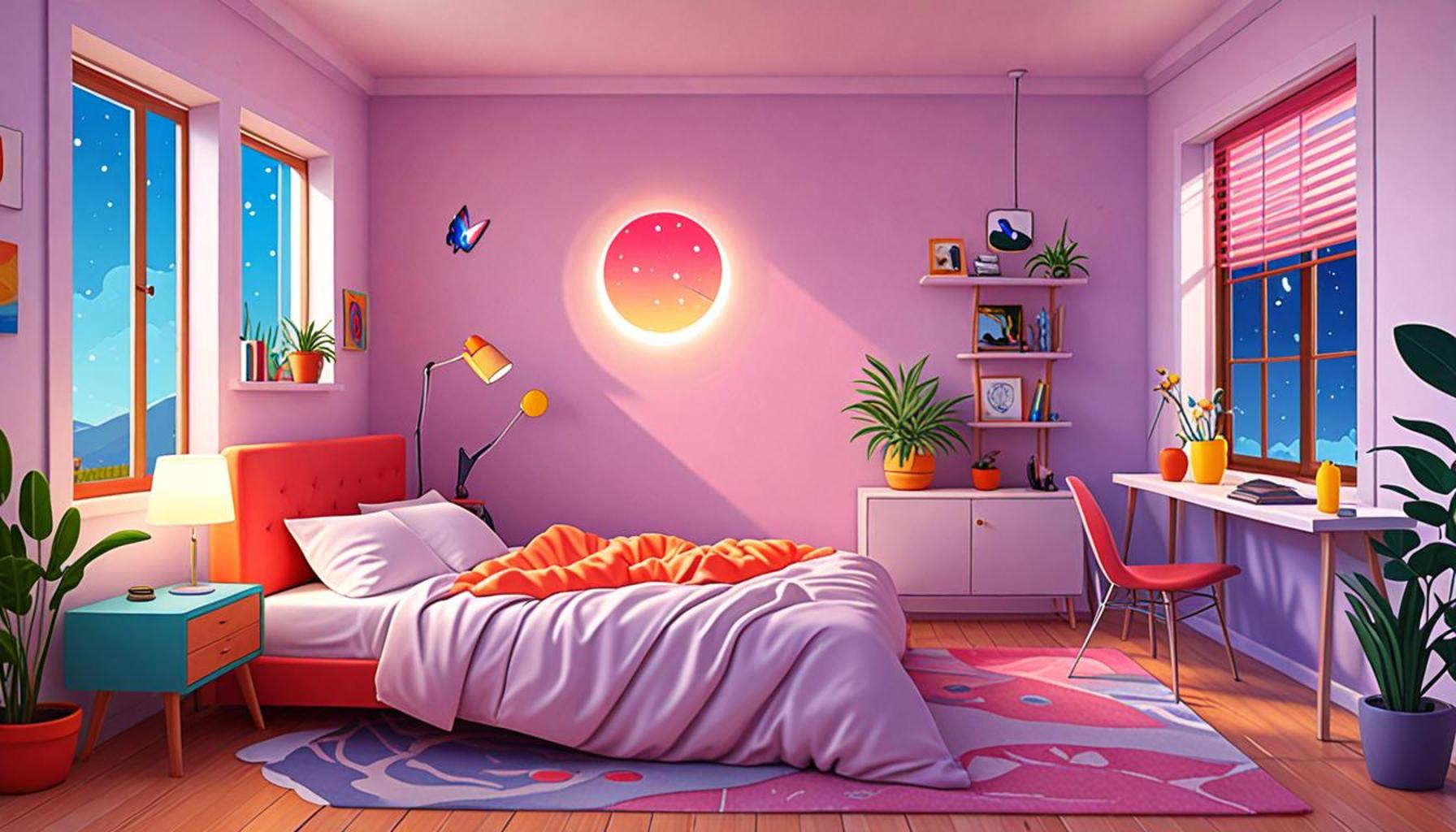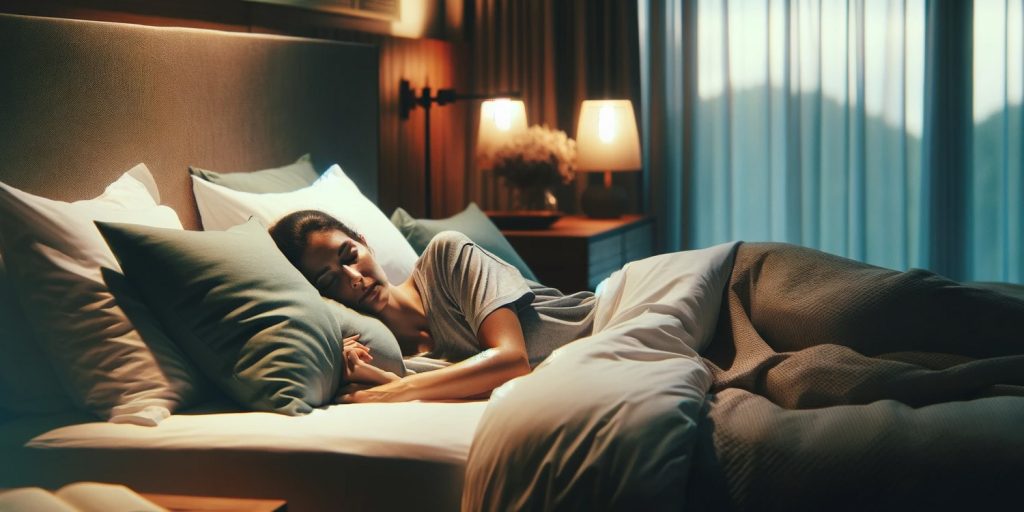The Influence of Simple Spaces on Sleep Quality: Creating Tranquil Environments for Effective Rest

The Importance of Sleep Quality
As societal demands rise and lifestyles become increasingly hectic, many individuals are finding themselves battling sleep disturbances. One pivotal aspect that has started to gain traction in addressing these issues is the design of personal spaces, particularly bedrooms. Optimizing your bedroom can have a transformative effect on sleep quality and overall well-being. Creating simple, tranquil spaces can lead to a calming environment that plays a crucial role in allowing the mind to unwind and embrace restful sleep.
The Characteristics of Tranquil Environments
Establishing a peaceful sleeping environment requires meticulous attention to various factors that can influence both mood and comfort:
- Minimalistic Decor: A cluttered space can be an immense source of distraction and anxiety. By adopting a minimalistic approach and removing unnecessary items, you create an atmosphere that fosters peace. For instance, an uncluttered bedside table with just a lamp and a book can contribute to a sense of calm.
- Natural Elements: Introducing plants into your bedroom can have outstanding effects on your well-being. Certain indoor plants, such as peace lilies or snake plants, not only purify the air but also help reduce carbon dioxide levels, promoting better sleep. This connection to nature can act as a stress reliever, encouraging relaxation.
- Soft Colors: The psychological impact of color should not be underestimated. Utilizing neutral and soft colors—like muted blues, greens, or beiges—can instill a sense of tranquility. These shades promote relaxation and mental clarity, making it easier to transition into sleep.
- Lighting: The intensity and warmth of lighting play a vital role in creating a conducive sleeping environment. Soft, warm lights can mimic natural lighting conditions, fostering a cozy atmosphere. Consider using dimmable lights or soft bedside lamps for a gentler glow in the evening hours.
In densely populated areas of Nigeria, where urban noise is an all-too-common disruption, the creation of a simple and serene space becomes even more vital. Soundproofing materials or heavy curtains can significantly reduce noise levels. Additionally, the use of a fan or white noise machine can mask external sounds, enhancing the potential for uninterrupted sleep.
The Power of Simplicity
Research suggests strong links between simple spaces and improvements in sleep patterns. A clearer and more organized room can minimize stress, enabling the body to transition into rest more smoothly. Scientific studies highlight how physical environments are intertwined with our mental health and sleep quality. For example, researchers have found that participants sleeping in well-organized and tranquil environments reported deeper and more restorative sleep.
Also, the benefits of a calming sleeping space can particularly resonate with the cultural context of Nigeria. In many instances, homes are multi-functional, and creating a bedroom that serves as a true sanctuary can be a challenge. However, even small adjustments—such as decluttering or introducing soothing elements—can drastically improve sleep quality.

Indeed, by understanding the critical interplay between our living spaces and sleep, we can make informed choices that promote better health. Exploring these adjustments can lead to a transformative cleansing of both our physical environment and our approach to rest, ultimately leading to a more rejuvenated existence.
YOU MAY ALSO LIKE: Read read another article
Transforming Bedrooms into Relaxing Sanctuaries
The quest for improved sleep quality often begins within the bedroom, the sanctuary where we seek solace from the pressures of daily life. Beyond mere aesthetics, the arrangement and design of this personal space can profoundly influence how we rest. By understanding the nuanced relationship between our environments and sleep, we can implement simple changes that foster a meditative atmosphere conducive to relaxation.
Key Elements That Enhance Sleep Quality
Creating a tranquil bedroom environment hinges on several key elements that work synergistically to curate a space where sleep can flourish:
- Comfortable Bedding: The quality of your mattress and pillows plays a crucial role in sleep. Opt for bedding that caters to your individual comfort preferences, whether that involves a firmer mattress for support or softer pillows for comfort. Investing in quality will pay off with deeper, uninterrupted sleep.
- Aromatherapy: Scents can significantly affect our moods and states of relaxation. Incorporating soothing scents like lavender or chamomile into your bedroom through essential oils or scented candles can promote feelings of calm and help regulate sleep patterns.
- Temperature Control: The ambient temperature of your bedroom can influence your sleep cycle. Most experts recommend keeping your room cool, around 18–20 degrees Celsius. This cooler environment can facilitate a more restful night by lowering your body’s core temperature, signaling that it is time for sleep.
- Decluttering: As previously mentioned, clutter can serve as a source of stress and distraction. A consistent effort to keep surfaces clear of unnecessary items allows for mental clarity and a peaceful mindset, which can be crucial during bedtime.
In regions like Nigeria, where humidity can be high, the physical environment can also play a vital role in sleep. Practical measures such as ensuring proper ventilation or utilizing breathable fabrics for bedding can contribute significantly to comfort levels, making it easier to drift off despite warmer temperatures.
Embracing Cultural Influences
In Nigeria, where diverse cultural traditions shape lifestyles, simplicity can resonate deeply. Many individuals live in multi-functional spaces where various activities, from work to leisure, converge. Despite these challenges, creating a dedicated sleep area encourages a strong psychological cue that signals the mind to unwind. Subtle changes, such as using bright, vibrant fabrics typical to Nigerian art for accents, can instill a sense of familiarity and comfort without overwhelming your senses. By blending cultural elements with simplicity, one can foster a tranquil environment that honors both personal heritage and the need for rest.
By acknowledging the impact of various design elements on sleep quality, we begin to unravel the means by which we can achieve restful nights and rejuvenated mornings. Our bedrooms can become more than mere sleeping quarters; they can evolve into sanctuaries that nurture our well-being and enhance our overall health.
The Influence of Color Psychology in Sleep Environments
When considering the impact of simple spaces on sleep quality, the psychology of color plays a crucial role. The colors present in our sleeping environments can significantly affect our mood, anxiety levels, and overall ability to rest. Soft, muted tones such as blues, greens, and pastels are scientifically shown to promote calmness and relaxation, reducing stress and anxiety. These colors create a serene backdrop conducive to effective sleep, overshadowing the more stimulating hues that can keep us awake and alert.
Minimalism and Sleep Quality
Embracing a minimalist approach to bedroom design can also enhance sleep quality. By eliminating clutter and unnecessary distractions, individuals create a peaceful sanctuary that encourages relaxation before bedtime. Minimalism’s emphasis on functional furniture and an organized space leads to a more tranquil environment, allowing for easier transition into sleep. Studies suggest that those who maintain such environments experience fewer interruptions during the night, highlighting the importance of simplicity in our living spaces.
Natural Elements and Sleep Enhancement
Incorporating elements of nature into the bedroom design can have profound effects on sleep quality. Items such as indoor plants not only purify the air but also introduce a sense of calm and connection with the outdoors. The presence of nature can help reduce stress levels and improve overall well-being, making it easier to fall asleep. The concept of biophilic design – which stresses the need for natural elements in our environments – is gaining traction as more people realize its positive impact on mental health and sleep.
| Category 1 | Category 2 |
|---|---|
| Color Psychology | Colors like blue and green promote calmness and relaxation. |
| Minimalist Design | A clutter-free environment helps transition into sleep more easily. |
| Natural Elements | Indoor plants enhance air quality and reduce stress levels. |
This exploration underscores the intricate relationship between our environmental choices and sleep quality. By prioritizing tranquil spaces, we can create effective settings that nurture our natural rhythms and enhance our nightly rest.
ADDITIONAL INSIGHTS: Expand your understanding here
Designing for Serenity: Color, Lighting, and Nature
As we dive deeper into the elements that foster a soothing sleep environment, we find that color, lighting, and nature play critical roles in shaping our bedroom sanctuaries. These factors can not only affect our emotions but also influence our circadian rhythms, which govern our sleep-wake cycles. Tailoring these elements to find the perfect balance is essential for creating a peaceful sleeping haven.
The Power of Color
The colors that surround us have a profound psychological impact, particularly in areas dedicated to rest. Soft, muted tones like pastels, light blues, and gentle greens are stereotypically associated with tranquility and calmness. Research suggests that these shades help reduce anxiety and create a serene ambiance conducive to sleep. In contrast, bold and vibrant colors may uplift and energize, which is counterproductive within a sleep space. Therefore, Nigerian homeowners can take cues from traditional palatial designs that incorporate soothing earth tones, melding modern simplicity with cultural heritage.
Illuminating Tranquility
The type and quality of lighting in your bedroom can significantly influence your body’s ability to relax and fall asleep. Soft, warm lighting mimics the natural shift of the day into night, signaling your brain that it is time to unwind. Utilizing dimmer switches or gentle bedside lamps allows for a customizable atmosphere that aids in soothing rituals before bed. Furthermore, research indicates that limiting exposure to harsh artificial light, particularly from electronic devices, is essential for improving sleep quality. Consider incorporating blackout curtains to block out unwanted light, creating a cocoon-like environment that promotes deeper rest.
Bringing Nature Indoors
Emphasizing a connection with nature can greatly enhance your sleeping quarters. Studies have shown that having plants in your bedroom can improve air quality and promote relaxation. Incorporating varieties like snake plants or peace lilies is not only beneficial for your physical environment but also serves as a beautiful decorative element. Additionally, integrating natural materials such as cotton for bedding or bamboo accents in furniture can create a sense of tranquility. In urban settings within Nigeria, where concrete often dominates, these natural elements can provide a refreshing contrast and grounding effect to the space.
Creating a Multi-Sensory Experience
To further enrich the sleep experience, integrating multi-sensory aspects into your bedroom design is essential. Sound, in particular, shouldn’t be overlooked, as ambient noise can be soothing for some. Introducing gentle sounds, such as calming music or white noise machines, can mask disruptive noises that may prevent restful sleep. Scented sachets or subtle essential oil diffusers facilitate an inviting olfactory experience, enhancing relaxation and sleep quality. In Nigeria, the traditional use of natural scents, such as sandalwood or jasmine, highlights the importance of culturally relevant elements in creating a serene atmosphere.
By thoughtfully combining color, lighting, and natural components into our bedroom design, we can forge a tranquil retreat that nurtures the mind and body. As we embrace these elements of our environment, our sleep quality can dramatically improve, paving the way for more rejuvenating experiences every night.
ADDITIONAL INSIGHTS: Expand your understanding here
Embracing Tranquility for Better Sleep
In our fast-paced world, the significance of a well-designed sleep space cannot be overstated. The influence of simple spaces on sleep quality is profound, as elements such as color, lighting, and nature work in harmony to promote effective rest. By embracing calming palettes that soothe the mind and integrating lighting that mimics natural rhythms, we can create environments that invite relaxation and tranquility. Furthermore, incorporating natural elements not only enhances the aesthetics of our bedrooms but also contributes to a healthier atmosphere, thereby improving sleep quality.
The journey towards achieving restful sleep is multifaceted, yet it can start with the simple act of re-evaluating our spaces. Multi-sensory experiences play a crucial role in enhancing this process—by introducing sounds, scents, and visual harmony, we can transform our sleep environment into a haven of peace.
As we consider our sleep environments, it is essential to recognize the cultural aspects that resonate within our designs. In Nigeria, where vibrant cultures thrive, incorporating traditional elements can create a unique blend of serenity and familiarity. The marriage of modern simplicity with cultural heritage offers an extraordinary opportunity to design for effective rest.
Ultimately, cultivating a tranquil space tailored for sleep is an investment in our health and well-being. By prioritizing simplicity and serenity in our surroundings, we unlock the potential for rejuvenating rest, propelling us towards brighter days. It is an invitation to explore how our environments shape our experiences, leading us toward a more restorative lifestyle—encouraging all to embrace the tranquility necessary for effective rest.



